
微机原理及接口技术(全英文) 四川大学制造科学与工程学院本科课程 《微机原理及接口技术(全英文)》教学大纲 课程编号: 302308020 课程类型: 必修课 Course Code:302308020 Course Type Compulsory 课程名称: 微机原理及接口技术(全英文) 授课对象: 本科三年级学生 Course Name: Microcontroller:Principle and Interfacing Audience: The junior Technology 学时/学分: 322 授课语言: 英语 Credit 622 Language of English Hours/Credits Instruction 先修课程: 模拟电子技术基础(Ⅱ)、数字电子技术开课院系: 机械工程系 基础(Ⅱ) Course offered by: Department of erequisite: Analog Electronic Technology (I).Digita Mechanical Eng Electronic Technology (ID) 适用专业: 机械设计制造及其自动化专业 授课数师: 余德平、汤卿、王凯 ended for: Mechanical Design,Manufacturing and 陶治 Automation nstructor: Yu Deping.Tang Qing.Wang Kai,Tao Ye 大纲执笔人: 余德平 大纲审核人 专业负责人 Edited by: Yu Deping Inspected by: Course Leader 一、课程简介 The microproces has been used for some30 years now.growing from an awkward 4-bit child to robust 64-bit adult.The engineering community became aware of,and enamored with,the 8-bit were particularly useful for specific tasks involving data gathering.machine control.human interaction. and many other applications that grantedalimited to machines and appliance The main contents of this module include the basic principle of the 8051 microcontroller,the hardware resources,the instruction set,the assembly language programming and the application of the 8051 microcontroller etc.Students are required to understand the internal hardware structure of the microcontroller,master the relevant instruction set and the assembly language programming.and apply the learned hardware and software knowledge to real-world applications. 二、学习目标
微机原理及接口技术(全英文) 四川大学制造科学与工程学院本科课程 《微机原理及接口技术(全英文)》教学大纲 课程编号: Course Code: 302308020 302308020 课程类型: Course Type: 必修课 Compulsory 课程名称: Course Name: 微机原理及接口技术(全英文) Microcontroller: Principle and Interfacing Technology 授课对象: Audience: 本科三年级学生 The junior 学时/学分: Credit Hours/Credits 32/2 32/2 授课语言: Language of Instruction 英语 English 先修课程: Prerequisite: 模拟电子技术基础(Ⅱ)、数字电子技术 基础(Ⅱ) Analog Electronic Technology (II), Digital Electronic Technology (II) 开课院系: Course offered by: 机械工程系 Department of Mechanical Eng. 适用专业: Intended for: 机械设计制造及其自动化专业 Mechanical Design, Manufacturing and Automation 授课教师: Instructor: 余德平、汤卿、王凯、 陶冶 Yu Deping, Tang Qing, Wang Kai, Tao Ye 大纲执笔人: Edited by: 余德平 Yu Deping 大纲审核人: Inspected by: 专业负责人 Course Leader 一、课程简介 The microprocessor has been used for some 30 years now, growing from an awkward 4-bit child to a robust 64-bit adult. The engineering community became aware of, and enamored with, the 8-bit microprocessors of the middle to late 1970s. The bit size, cost and power of these 8-bit microcontrollers were particularly useful for specific tasks involving data gathering, machine control, human interaction, and many other applications that granted a limited intelligence to machines and appliance. The main contents of this module include the basic principle of the 8051 microcontroller, the hardware resources, the instruction set, the assembly language programming and the application of the 8051 microcontroller etc. Students are required to understand the internal hardware structure of the microcontroller, master the relevant instruction set and the assembly language programming, and apply the learned hardware and software knowledge to real-world applications. 二、学习目标 1
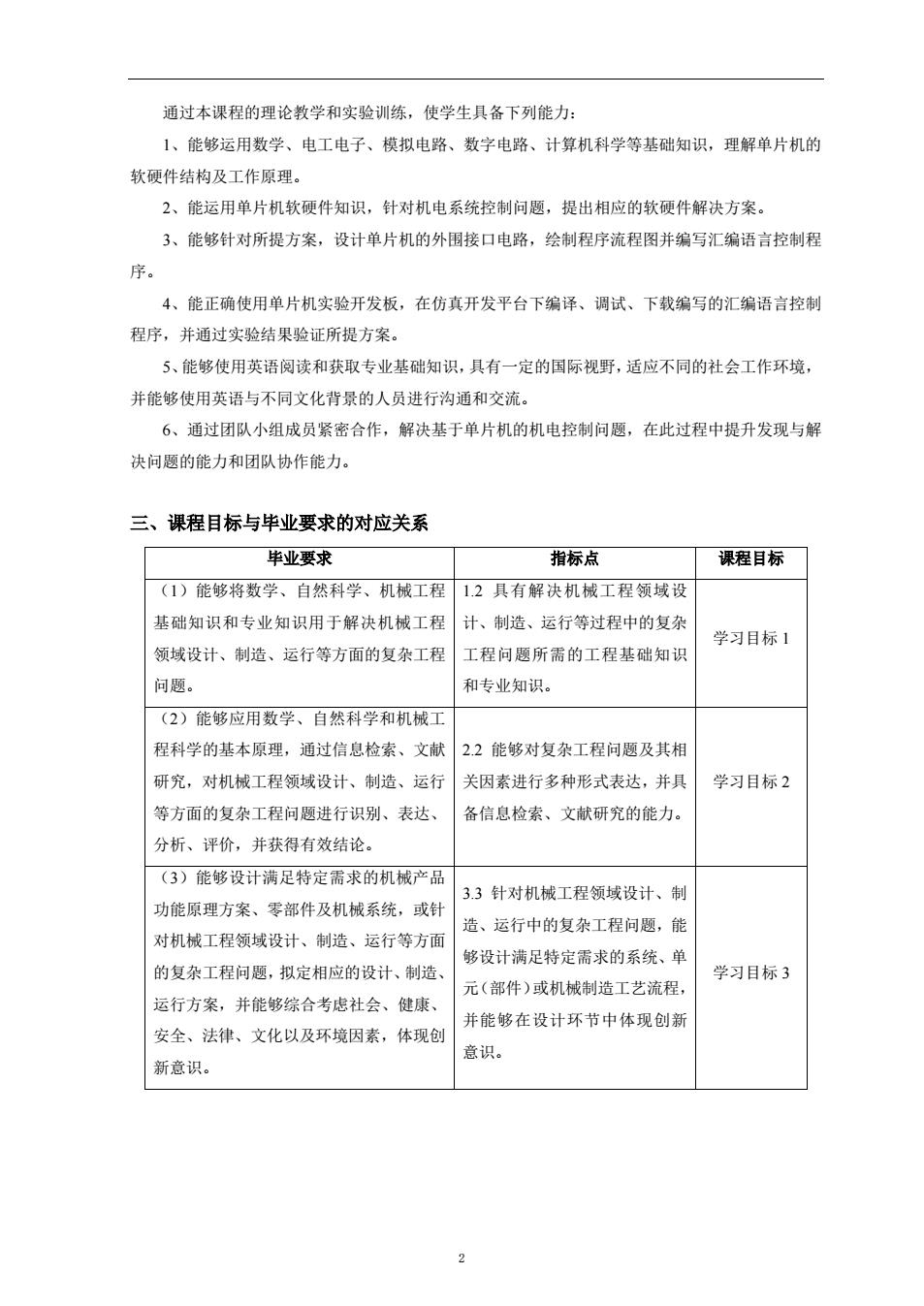
通过本课程的理论教学和实验训练,使学生具备下列能力: 1、能够运用数学、电工电子、模拟电路、数字电路、计算机科学等基础知识,理解单片机的 软硬件结构及工作原理。 2、能运用单片机软硬件知识,针对机电系统控制问题,提出相应的软硬件解决方案。 3、能够针对所提方案,设计单片机的外围接口电路,绘制程序流程图并编写汇编语言控制程 序。 4、能正确使用单片机实验开发板,在仿真开发平台下编译、调试、下载编写的汇编语言控制 程序,并通过实验结果验证所提方案。 5、能够使用英语阅读和获取专业基础知识,具有一定的国际视野,适应不同的社会工作环境, 并能够使用英语与不同文化背景的人员进行沟通和交流。 6、通过团队小组成员紧密合作,解决基于单片机的机电控制问题,在此过程中提升发现与解 决问题的能力和团队协作能力。 三、课程目标与毕业要求的对应关系 毕业要求 指标点 课程目标 (1)能够将数学、自然科学、机械工程1,2具有解决机械工程领域设 基础知识和专业知识用于解决机械工程计、制造、运行等过程中的复东 学习目标 领域设计、制造、运行等方面的复杂工程工程问题所需的工程基础知识 问题。 和专业知识。 (2)能够应用数学、自然科学和机械工 程科学的基本原理,通过信总检索、文献 2.2能够对复杂工程问题及其相 研究,对机械工程领域设计、制造、运行 关因素进行多种形式表达,并具 学习目标2 等方面的复杂工程问题进行识别、表达、 备信息检索、文献研究的能力 分析、评价,并获得有效结论。 (3)能够设计满足特定需求的机械产品 33针对机械工程领域设计、制 功能原理方案、零部件及机械系统,或针 造、运行中的复杂工程问题,能 对机械工程领域设计、制造、运行等方面 够设计满足特定需求的系统、单 的复杂工程问题,拟定相应的设计、制造、 学习目标3 元(部件)或机械制造工艺流程 运行方案,并能够综合考虑社会、健康、 并能够在设计环节中体现创新 安全、法律、文化以及环境因素,体现创 意识。 新意识
通过本课程的理论教学和实验训练,使学生具备下列能力: 1、能够运用数学、电工电子、模拟电路、数字电路、计算机科学等基础知识,理解单片机的 软硬件结构及工作原理。 2、能运用单片机软硬件知识,针对机电系统控制问题,提出相应的软硬件解决方案。 3、能够针对所提方案,设计单片机的外围接口电路,绘制程序流程图并编写汇编语言控制程 序。 4、能正确使用单片机实验开发板,在仿真开发平台下编译、调试、下载编写的汇编语言控制 程序,并通过实验结果验证所提方案。 5、能够使用英语阅读和获取专业基础知识,具有一定的国际视野,适应不同的社会工作环境, 并能够使用英语与不同文化背景的人员进行沟通和交流。 6、通过团队小组成员紧密合作,解决基于单片机的机电控制问题,在此过程中提升发现与解 决问题的能力和团队协作能力。 三、课程目标与毕业要求的对应关系 毕业要求 指标点 课程目标 (1)能够将数学、自然科学、机械工程 基础知识和专业知识用于解决机械工程 领域设计、制造、运行等方面的复杂工程 问题。 1.2 具有解决机械工程领域设 计、制造、运行等过程中的复杂 工程问题所需的工程基础知识 和专业知识。 学习目标 1 (2)能够应用数学、自然科学和机械工 程科学的基本原理,通过信息检索、文献 研究,对机械工程领域设计、制造、运行 等方面的复杂工程问题进行识别、表达、 分析、评价,并获得有效结论。 2.2 能够对复杂工程问题及其相 关因素进行多种形式表达,并具 备信息检索、文献研究的能力。 学习目标 2 (3)能够设计满足特定需求的机械产品 功能原理方案、零部件及机械系统,或针 对机械工程领域设计、制造、运行等方面 的复杂工程问题,拟定相应的设计、制造、 运行方案,并能够综合考虑社会、健康、 安全、法律、文化以及环境因素,体现创 新意识。 3.3 针对机械工程领域设计、制 造、运行中的复杂工程问题,能 够设计满足特定需求的系统、单 元(部件)或机械制造工艺流程, 并能够在设计环节中体现创新 意识。 学习目标 3 2
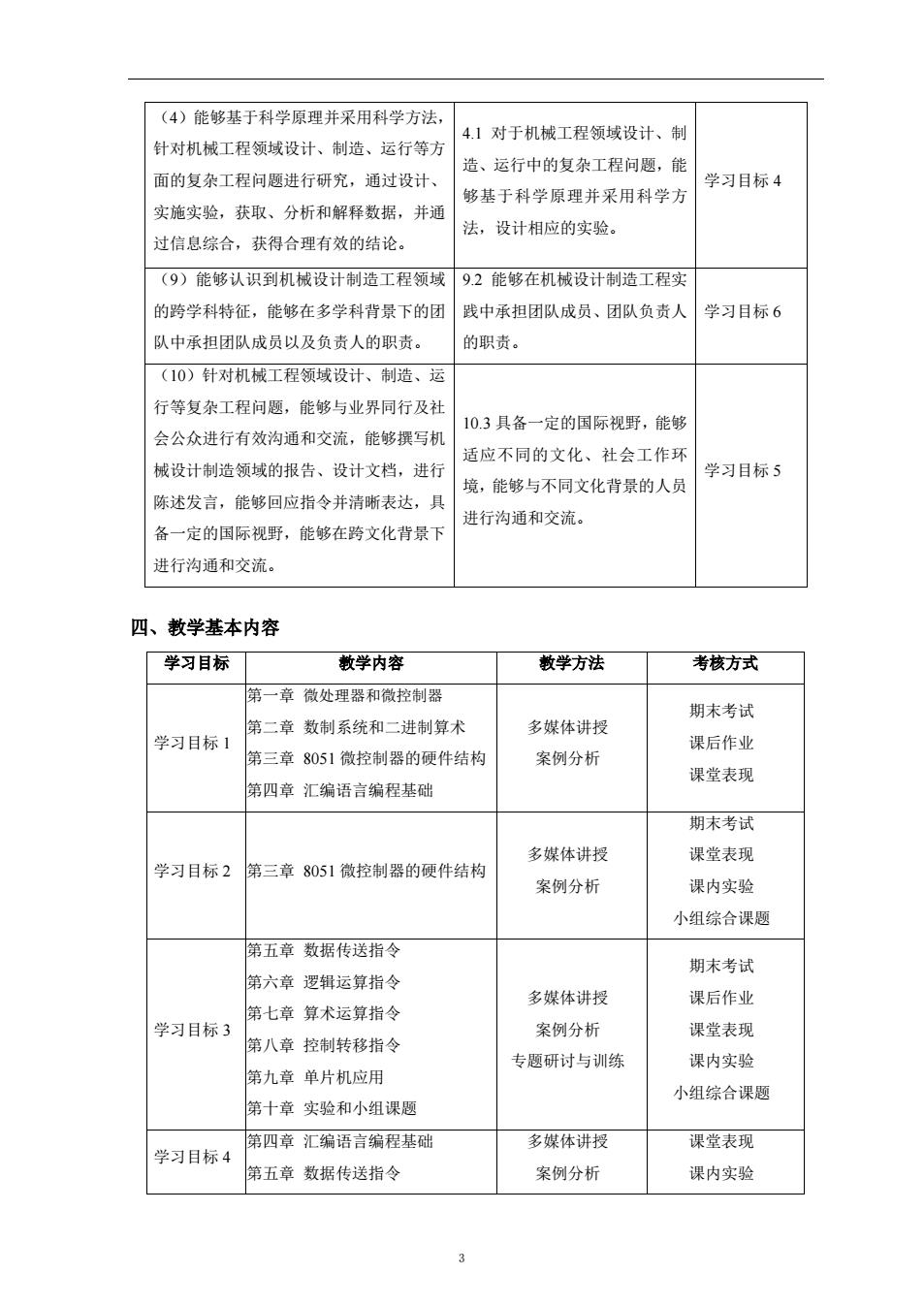
(4)能够基于科学原理并采用科学方法, 针对机械工程领域设计、制造、运行等方 4.1对于机械工程领域设计、制 面的复杂工程问题进行研究,通过设计、 造、运行中的复杂工程问题,能 学习目标4 够基于科学原理并采用科学方 实施实验,获取、分析和解释数据,并通 法,设计相应的实验。 过信息综合,获得合理有效的结论。 (9)能够认识到机械设计制造工程领域92能够在机械设计制造工程实 的跨学科特征,能够在多学科背景下的团践中承担团队成员、团队负责人 学习目标6 队中承担团队成员以及负责人的职责。 的职责。 (10)针对机械工程领域设计、制造、运 行等复杂工程问题,能够与业界同行及社 10.3具备一定的国际视野,能够 会公众进行有效沟通和交流,能够撰写机 械设计制造领域的报告、设计文档,进行 适应不同的文化、社会工作环 学习目标5 境,能够与不同文化背景的人员 陈述发言,能够回应指令并清晰表达,具 进行沟通和交流。 备一定的国际视野,能够在跨文化背景下 进行沟通和交流。 四、教学基本内容 学习目标 教学内容 教学方法 考核方式 一章微处理器和微控制器 期末考试 第二章数制系统和二进制算术 多媒体讲授 学习目标1 第三章8051微控制器的硬件结构 案例分析 课后作业 课堂表现 璃四章汇编语言编程基础 期末考试 多媒体讲授 课堂表现 学习目标 第三章8051微控制器的硬件结构 案例分析 课内实验 小组综合课题 第五章数据传送指令 期末考试 第六章逻辑运算指令 多媒体讲授 课后作业 第七章算术运算指令 学习目标3 第八章控制转移指令 案例分析 课堂表现 专题研讨与训练 课内实验 第九章单片机应用 小组综合课题 第十章实验和小组课题 第四章汇编语言编程基础 多媒体讲授 课堂表现 学习目标4 第五章数据传送指令 案例分析 课内实验
(4)能够基于科学原理并采用科学方法, 针对机械工程领域设计、制造、运行等方 面的复杂工程问题进行研究,通过设计、 实施实验,获取、分析和解释数据,并通 过信息综合,获得合理有效的结论。 4.1 对于机械工程领域设计、制 造、运行中的复杂工程问题,能 够基于科学原理并采用科学方 法,设计相应的实验。 学习目标 4 (9)能够认识到机械设计制造工程领域 的跨学科特征,能够在多学科背景下的团 队中承担团队成员以及负责人的职责。 9.2 能够在机械设计制造工程实 践中承担团队成员、团队负责人 的职责。 学习目标 6 (10)针对机械工程领域设计、制造、运 行等复杂工程问题,能够与业界同行及社 会公众进行有效沟通和交流,能够撰写机 械设计制造领域的报告、设计文档,进行 陈述发言,能够回应指令并清晰表达,具 备一定的国际视野,能够在跨文化背景下 进行沟通和交流。 10.3 具备一定的国际视野,能够 适应不同的文化、社会工作环 境,能够与不同文化背景的人员 进行沟通和交流。 学习目标 5 四、教学基本内容 学习目标 教学内容 教学方法 考核方式 学习目标 1 第一章 微处理器和微控制器 第二章 数制系统和二进制算术 第三章 8051 微控制器的硬件结构 第四章 汇编语言编程基础 多媒体讲授 案例分析 期末考试 课后作业 课堂表现 学习目标 2 第三章 8051 微控制器的硬件结构 多媒体讲授 案例分析 期末考试 课堂表现 课内实验 小组综合课题 学习目标 3 第五章 数据传送指令 第六章 逻辑运算指令 第七章 算术运算指令 第八章 控制转移指令 第九章 单片机应用 第十章 实验和小组课题 多媒体讲授 案例分析 专题研讨与训练 期末考试 课后作业 课堂表现 课内实验 小组综合课题 学习目标 4 第四章 汇编语言编程基础 第五章 数据传送指令 多媒体讲授 案例分析 课堂表现 课内实验 3
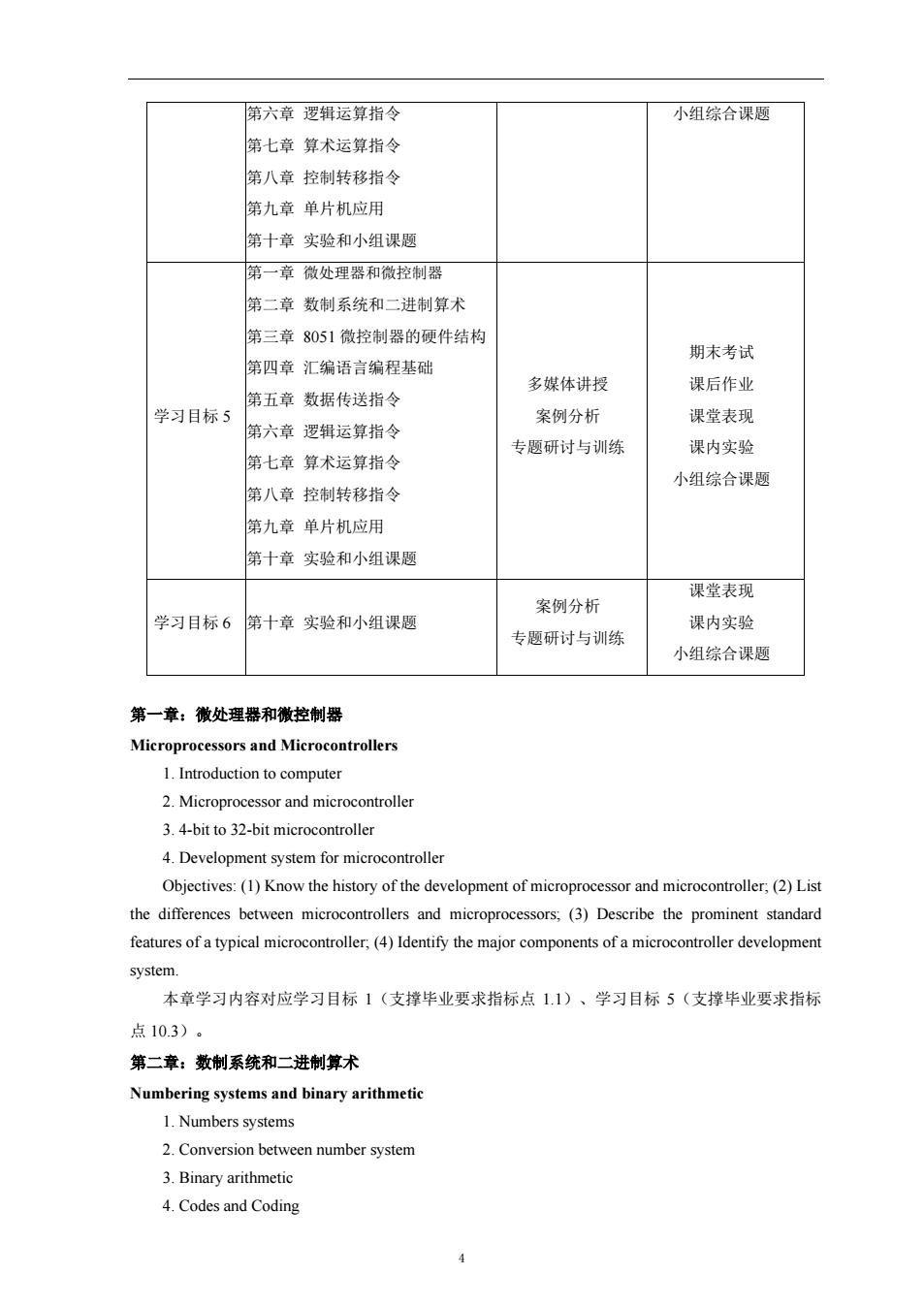
第六章逻辑运算指令 小组综合课题 第七章算术运算指令 第八章控制转移指令 第九章单片机应用 第十章实验和小组课题 第一章微处理器和微控制器 第二章数制系统和二进制算术 第三章8051微控制器的硬件结构 期末考试 第四章汇编语言编程基础 多媒体讲授 课后作业 第五章数据传送指令 学习目标 案例分析 课堂表现 第六章逻辑运算指令 专题研讨与训练 课内实验 第七章算术运算指令 第八章控制转移指令 小组综合课题 第九章单片机应用 第十章实验和小组课题 课堂表现 案例分析 学习目标6 第十章实验和小组课题 专题研讨与训练 课内实验 小组综合课题 第一章:徽处理器和徽控制器 Microp cessors and microcontrollers 1.Introduction to computer 2.Microprocessor and microcontroller 3.4-bit to 32-bit microcontroller 4.Development system for Objectives:(1)Know the history of the development of microprocessor and microcontroller,(2)List the differences between and microprocessors.()Describe the prominent standard features of a typical microcontroller,(4)Identify the major components of a microcontroller development system 本章学习内容对应学习目标1(支撑毕业要求指标点1.1)、学习目标5(支撑毕业要求指标 点103)。 第二章:数制系统和二进制算术 Numbering systems and binary arithmeti 1.Numbers systems 2.Conversion between number system 3.Binary arithmetic 4.Codes and Coding
第六章 逻辑运算指令 第七章 算术运算指令 第八章 控制转移指令 第九章 单片机应用 第十章 实验和小组课题 小组综合课题 学习目标 5 第一章 微处理器和微控制器 第二章 数制系统和二进制算术 第三章 8051 微控制器的硬件结构 第四章 汇编语言编程基础 第五章 数据传送指令 第六章 逻辑运算指令 第七章 算术运算指令 第八章 控制转移指令 第九章 单片机应用 第十章 实验和小组课题 多媒体讲授 案例分析 专题研讨与训练 期末考试 课后作业 课堂表现 课内实验 小组综合课题 学习目标 6 第十章 实验和小组课题 案例分析 专题研讨与训练 课堂表现 课内实验 小组综合课题 第一章:微处理器和微控制器 Microprocessors and Microcontrollers 1. Introduction to computer 2. Microprocessor and microcontroller 3. 4-bit to 32-bit microcontroller 4. Development system for microcontroller Objectives: (1) Know the history of the development of microprocessor and microcontroller; (2) List the differences between microcontrollers and microprocessors; (3) Describe the prominent standard features of a typical microcontroller; (4) Identify the major components of a microcontroller development system. 本章学习内容对应学习目标 1(支撑毕业要求指标点 1.1)、学习目标 5(支撑毕业要求指标 点 10.3)。 第二章:数制系统和二进制算术 Numbering systems and binary arithmetic 1. Numbers systems 2. Conversion between number system 3. Binary arithmetic 4. Codes and Coding 4
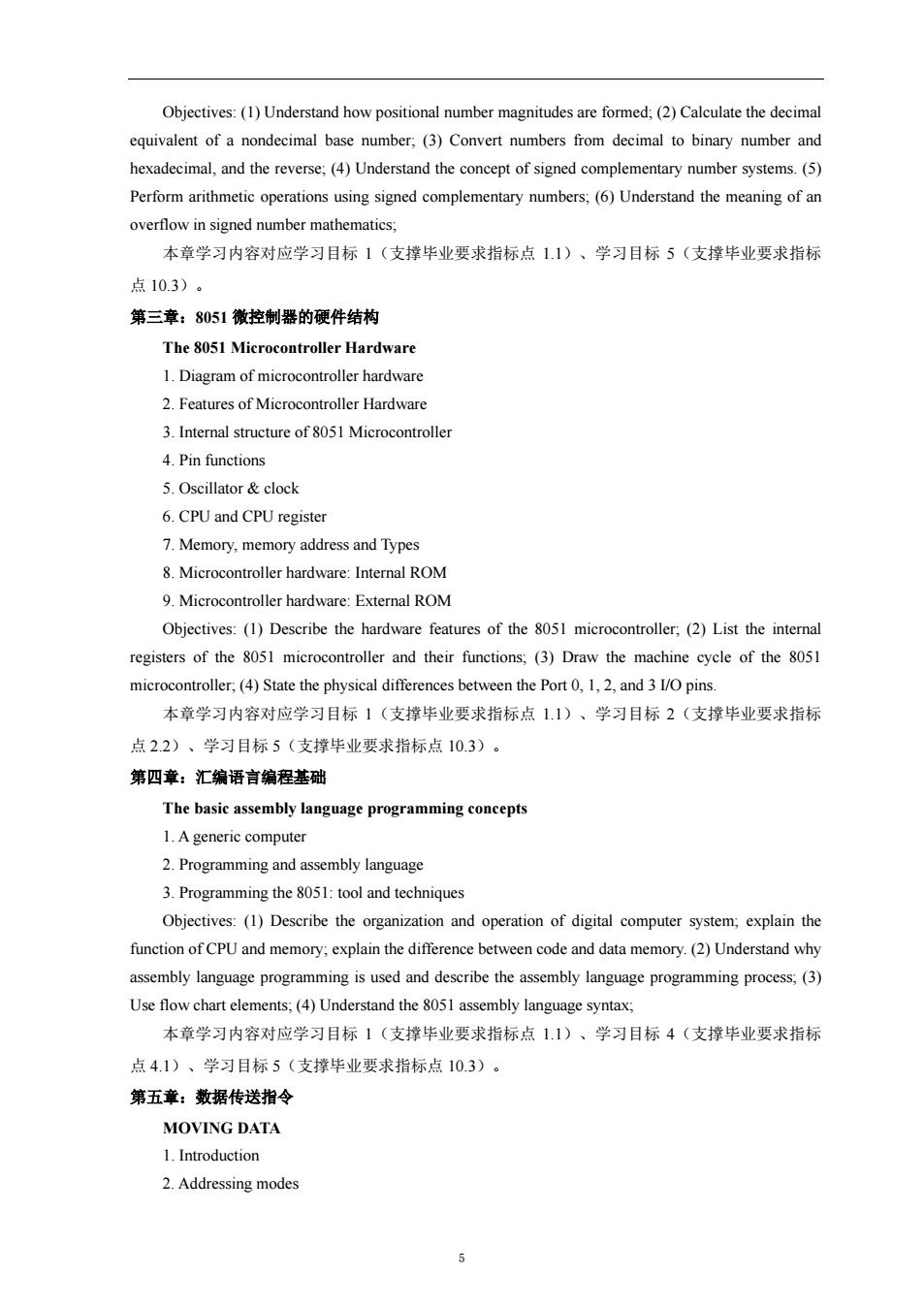
Objectives:(1)Understand how positional number magnitudes are formed:(2)Calculate the decimal equivalent of a nondecimal base number,(3)Convert numbers from decimal to binary number and hexadecimal.and the reverse:(4)Understand the concept of signed complementary number systems.(5) Perform arithmetic operations using signed complementary numbers,(6)Understand the meaning of an overflow in signed number mathematics: 本章学习内容对应学习目标1(支撑毕业要求指标点11)、学习目标5(支撑毕业要求指标 点10.3)。 第三章:8051徽控制器的硬件结构 The 8051 Microcontroller Hardware 1.Diagram of microcontroller hardware 2.Features of Microcontroller Hardware 3.Internal structure of 8051 Microcontroller 4.Pin functions 5.Oscillator clock 6.CPU and CPU registe 7.Memory,memory address and Types 8.Microcontroller hardware:Internal ROM 9.Microcontroller hardware:External ROM Objectives:(1)Describe the hardware features of the 8051 microcontroller,(2)List the interna registers of the 8051 microcontroller and their functions:(3)Draw the machine cycle of the 8051 microcontroller,(4)State the physical differences between the Port ,1,2,and 31/O pins. 本章学习内容对应学习目标1(支撑毕业要求指标点1.1)、学习目标2(支撑毕业要求指标 点2.2)、学习目标5(支撑毕业要求指标点103)。 第四章:汇编语言编程基础 The basic assembly language programming concepts 1.Ageneric computer 2.Programming and assembly language 3.Programming the 851:tool and techniques Objectives:(1)Describe the organization and operation of digital computer system;explain the function of CPU and memory:explain the difference between code and data memory.(2)Understand why assembly language programming is used and describe the assembly language programming process:(3) Useflow chart elements (4)Understand the 851assembly language syntax 本章学习内容对应学习目标1(支撑毕业要求指标点1.1)、学习目标4(支撑毕业要求指标 点4.1)、学习目标5(支撑毕业要求指标点10.3)。 第五章:数据传送指令 MOVING DATA 1.Introduction 2.Addressing modes
Objectives: (1) Understand how positional number magnitudes are formed; (2) Calculate the decimal equivalent of a nondecimal base number; (3) Convert numbers from decimal to binary number and hexadecimal, and the reverse; (4) Understand the concept of signed complementary number systems. (5) Perform arithmetic operations using signed complementary numbers; (6) Understand the meaning of an overflow in signed number mathematics; 本章学习内容对应学习目标 1(支撑毕业要求指标点 1.1)、学习目标 5(支撑毕业要求指标 点 10.3)。 第三章:8051 微控制器的硬件结构 The 8051 Microcontroller Hardware 1. Diagram of microcontroller hardware 2. Features of Microcontroller Hardware 3. Internal structure of 8051 Microcontroller 4. Pin functions 5. Oscillator & clock 6. CPU and CPU register 7. Memory, memory address and Types 8. Microcontroller hardware: Internal ROM 9. Microcontroller hardware: External ROM Objectives: (1) Describe the hardware features of the 8051 microcontroller; (2) List the internal registers of the 8051 microcontroller and their functions; (3) Draw the machine cycle of the 8051 microcontroller; (4) State the physical differences between the Port 0, 1, 2, and 3 I/O pins. 本章学习内容对应学习目标 1(支撑毕业要求指标点 1.1)、学习目标 2(支撑毕业要求指标 点 2.2)、学习目标 5(支撑毕业要求指标点 10.3)。 第四章:汇编语言编程基础 The basic assembly language programming concepts 1. A generic computer 2. Programming and assembly language 3. Programming the 8051: tool and techniques Objectives: (1) Describe the organization and operation of digital computer system; explain the function of CPU and memory; explain the difference between code and data memory. (2) Understand why assembly language programming is used and describe the assembly language programming process; (3) Use flow chart elements; (4) Understand the 8051 assembly language syntax; 本章学习内容对应学习目标 1(支撑毕业要求指标点 1.1)、学习目标 4(支撑毕业要求指标 点 4.1)、学习目标 5(支撑毕业要求指标点 10.3)。 第五章:数据传送指令 MOVING DATA 1. Introduction 2. Addressing modes 5

3.Overview of moving data instructions 4.Internal data moves 5.External data moves 6.Push and pop opcode 7.Data exchanges 8.Programming examples:Moving data Objectives:(1)Use commands that place data in registers,intemal memory and extemal memory,(2) Understand the data address modes:(3)Understand and master the data moving instructions.including internal data moves,external data moves,push and pop opcodes,and data exchanges;(4)Master the moving data instructions through programming examples,(5)Master the logical operation instructions. 本章学习内容对应学习目标3(支摔毕业要求指标点3.3)、学习目标4(支撑毕业要求指材 点4.1)、学习目标5(支撑毕业要求指标点10.3)。 第大章:逻辑运算指令 LOGICAL OPERATIONS 1.Byte-level logical operations 2.Bit-level logical operations 3.Rotate operations 4.Programming examples:Logical operations Objectives:(1)Master the moving data instructions through programming examples:2.Master the logical operation instructions 本章学习内容对应学习目标3(支撑毕业要求指标点3.3)、学习目标4(支撑毕业要求指标 点4,1)、学习目标5(支撑毕业要求指标点10.3)。 第七章:算术运算指令 ARITHMETIC OPERATIONS 1.Introduction:arithmetic operations and flags 2.Addition and subtraction 3.Multiplication and division 4.BCDadjustment 5.Programming examples Objectives:(1)Master the arithmetic operations of microcontroller,including incremen and decrement of the contents of register and RAM,addition,subtraction,multiplication,division and BCD addition. 本章学习内容对应学习目标3(支撑毕业要求指标点3.3)、学习目标4(支撑毕业要求指标 点4.1)、学习目标5(支撑毕业要求指标点103)。 第八章:控制转移指令 JUMPAND CALL INSTRUCTIONS 1.Introduction 2.The jump and call program range
3. Overview of moving data instructions 4. Internal data moves 5. External data moves 6. Push and pop opcodes 7. Data exchanges 8. Programming examples: Moving data Objectives: (1) Use commands that place data in registers, internal memory and external memory; (2) Understand the data address modes; (3) Understand and master the data moving instructions, including internal data moves, external data moves, push and pop opcodes, and data exchanges; (4) Master the moving data instructions through programming examples; (5) Master the logical operation instructions. 本章学习内容对应学习目标 3(支撑毕业要求指标点 3.3)、学习目标 4(支撑毕业要求指标 点 4.1)、学习目标 5(支撑毕业要求指标点 10.3)。 第六章:逻辑运算指令 LOGICAL OPERATIONS 1. Byte-level logical operations 2. Bit-level logical operations 3. Rotate operations 4. Programming examples: Logical operations Objectives: (1) Master the moving data instructions through programming examples;2. Master the logical operation instructions 本章学习内容对应学习目标 3(支撑毕业要求指标点 3.3)、学习目标 4(支撑毕业要求指标 点 4.1)、学习目标 5(支撑毕业要求指标点 10.3)。 第七章:算术运算指令 ARITHMETIC OPERATIONS 1. Introduction: arithmetic operations and flags 2. Addition and subtraction 3. Multiplication and division 4.BCD adjustment 5.Programming examples Objectives: (1) Master the arithmetic operations of the 8051 microcontroller, including increment and decrement of the contents of register and RAM, addition, subtraction, multiplication, division and BCD addition. 本章学习内容对应学习目标 3(支撑毕业要求指标点 3.3)、学习目标 4(支撑毕业要求指标 点 4.1)、学习目标 5(支撑毕业要求指标点 10.3)。 第八章:控制转移指令 JUMP AND CALL INSTRUCTIONS 1. Introduction 2.The jump and call program range 6

3 Jumps 4.Calls and returs 5.Programming examples:branch,loop,subroutines and arithmetic operation Objectives:(1)Understand the function and range of jump and call instructions,(2)Use the bit and byte conditional jump opcodes.and unconditional jump opcodes:(3)Write and call subroutines.(4) Master the use of jump and call instructions to change the program flow through programming examples (5)Master assembly language programming structure,including the sequential,branch and loop program 本章学习内容对应学习目标3(支撑毕业要求指标点3.3)、学习目标4(支撑毕业要求指标 点4.1)、学习目标5(支撑毕业要求指标点10.3)。 第九章:单片机应用 APPLICATIONS 1.Interrupt system 2.Timer/counter 3.Serial port 4.Labson traffic lights Objectives:(1)Understand the concept and master the use of interrupt system;(2)Understand the concept and master the use of Timer/Counter,()Understand the concept and master the use of seria port. 本章学习内容对应学习目标3(支撑毕业要求指标点33)、学习目标4(支撑毕业要求指标 点4.1)、学习目标5(支撑毕业要求指标点10.3)。 第十章实验和小组课题 Labs and Group Project Student groups are required to demonstrate and discuss the solutions of the projects on the real-world applications of. Objeetives:Comprehensive understanding and use of knowledge learned in this course to solve real-world applications 本章学习内容对应学习目标3(支撑毕业要求指标点3.3)、学习目标4(支撑毕业要求指标 点4.1)、学习目标5(10.3)、学习目标6(支撑毕业要求指标点9.2)。 五、建议教学进度 章节名称 学时数 1、微处理器和微控制器 2、数制系统和二进制算术 3、8051微控制器的硬件结构 4、汇编语言编程基础 5、数据传送指令 6、逻辑运算指令 7
3.Jumps 4.Calls and returns 5. Programming examples: branch, loop, subroutines and arithmetic operation Objectives: (1) Understand the function and range of jump and call instructions; (2) Use the bit and byte conditional jump opcodes, and unconditional jump opcodes; (3) Write and call subroutines. (4) Master the use of jump and call instructions to change the program flow through programming examples; (5) Master assembly language programming structure, including the sequential, branch and loop program. 本章学习内容对应学习目标 3(支撑毕业要求指标点 3.3)、学习目标 4(支撑毕业要求指标 点 4.1)、学习目标 5(支撑毕业要求指标点 10.3)。 第九章:单片机应用 APPLICATIONS 1. Interrupt system 2. Timer/counter 3. Serial port 4. Labs on traffic lights Objectives: (1) Understand the concept and master the use of interrupt system; (2) Understand the concept and master the use of Timer/Counter; (3) Understand the concept and master the use of serial port. 本章学习内容对应学习目标 3(支撑毕业要求指标点 3.3)、学习目标 4(支撑毕业要求指标 点 4.1)、学习目标 5(支撑毕业要求指标点 10.3)。 第十章实验和小组课题 Labs and Group Project Student groups are required to demonstrate and discuss the solutions of the projects on the real-world applications of microcontroller. Objectives: Comprehensive understanding and use of knowledge learned in this course to solve real-world applications 本章学习内容对应学习目标 3(支撑毕业要求指标点 3.3)、学习目标 4(支撑毕业要求指标 点 4.1)、学习目标 5(10.3)、学习目标 6(支撑毕业要求指标点 9.2)。 五、建议教学进度 章节名称 学时数 1、微处理器和微控制器 1 2、数制系统和二进制算术 2 3、8051 微控制器的硬件结构 6 4、汇编语言编程基础 2 5、数据传送指令 4 6、逻辑运算指令 1 7
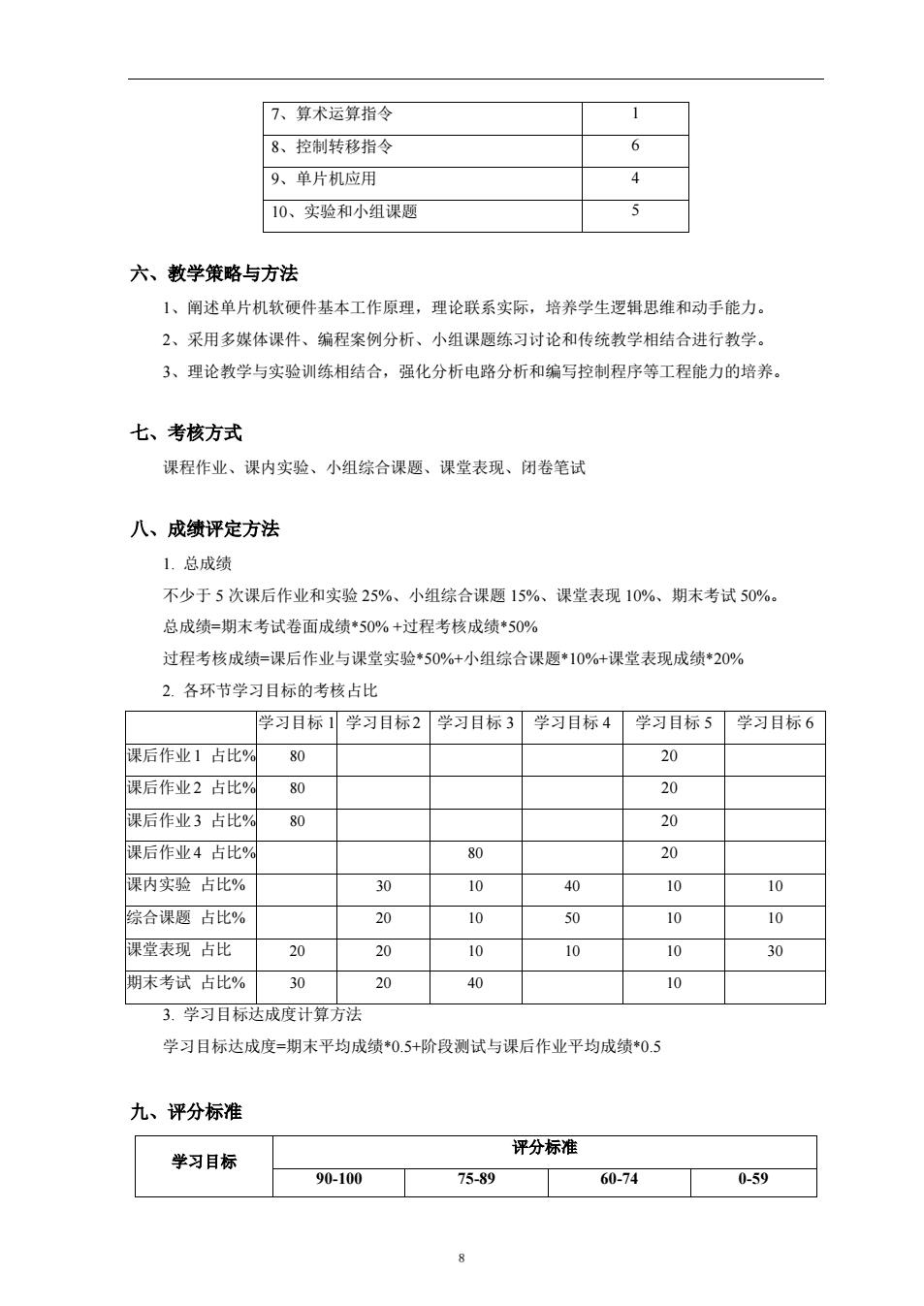
7、算术运算指令 8、控制转移指令 9、单片机应用 10、实验和小组课题 六、教学策略与方法 1、阐述单片机软硬件基本工作原理,理论联系实际,培养学生逻辑思维和动手能力。 2、采用多媒体课件、编程案例分析、小组课题练习讨论和传统教学相结合进行教学。 3、理论教学与实验训练相结合,强化分析电路分析和编写控制程序等工程能力的培养 七、考核方式 课程作业、课内实验、小组综合课题、课堂表现、闭卷笔试 八、成绩评定方法 1.总成绩 不少于5次课后作业和实验25%、小组综合课题15%、课堂表现10%、期末考试50%。 总成绩=期末考试卷面成绩*50%+过程考核成绩*50% 过程考核成绩=课后作业与课堂实验*50%+小组综合课题*10%+课堂表现成绩20 2.各环节学习目标的考核占比 学习目标学习目标2学习目标3学习目标4学习目标5学习目标6 课后作业1占比%80 20 课后作业2占比% 80 20 课后作业3占比% 80 20 课后作业4占比0 80 课内实验占比 30 10 40 10 10 综合课题占比% 20 10 50 10 10 课常表现占比 20 20 10 10 10 30 期末考试占比% 30 20 40 3.学习目标达成度计算方法 学习目标达成度=期末平均成绩*0.5+阶段测试与课后作业平均成绩0.5 九、评分标准 评分标准 学习目标 90-100 75-89 60-74 0-59
7、算术运算指令 1 8、控制转移指令 6 9、单片机应用 4 10、实验和小组课题 5 六、教学策略与方法 1、阐述单片机软硬件基本工作原理,理论联系实际,培养学生逻辑思维和动手能力。 2、采用多媒体课件、编程案例分析、小组课题练习讨论和传统教学相结合进行教学。 3、理论教学与实验训练相结合,强化分析电路分析和编写控制程序等工程能力的培养。 七、考核方式 课程作业、课内实验、小组综合课题、课堂表现、闭卷笔试 八、成绩评定方法 1. 总成绩 不少于 5 次课后作业和实验 25%、小组综合课题 15%、课堂表现 10%、期末考试 50%。 总成绩=期末考试卷面成绩*50% +过程考核成绩*50% 过程考核成绩=课后作业与课堂实验*50%+小组综合课题*10%+课堂表现成绩*20% 2. 各环节学习目标的考核占比 学习目标 1 学习目标2 学习目标 3 学习目标 4 学习目标 5 学习目标 6 课后作业1 占比% 80 20 课后作业2 占比% 80 20 课后作业3 占比% 80 20 课后作业4 占比% 80 20 课内实验 占比% 30 10 40 10 10 综合课题 占比% 20 10 50 10 10 课堂表现 占比 20 20 10 10 10 30 期末考试 占比% 30 20 40 10 3. 学习目标达成度计算方法 学习目标达成度=期末平均成绩*0.5+阶段测试与课后作业平均成绩*0.5 九、评分标准 学习目标 评分标准 90-100 75-89 60-74 0-59 8

良 中/及格 不及格 1。能够运用数学、 电工电子、模拟电 路、数字电路、计能够全面准确理解能够准确理解单能够理解单片机不能理解单片机 算机科学等基础知单片机的软硬件结片机的软硬件结的软硬件结构及的软硬件结构及 识,理解单片机的构及工作原理 构及工作原理 工作原理 工作原理 软硬件结构及工作 原理 2。能运用单片机软 能够熟练准确地运能够准确地运用能够运用单片机 不能运用单片机 硬件知识,针对机 用单片机软硬件知单片机软硬件知软硬件知识提出 软硬件知识提出 电系统控制间题 识提出相应的软硬识提出相应的软相应的软硬件解 相应的软硬件解 提出相应的软硬件 件解决方室 硬件解决方案 决方案 快方案 解决方案 3.能够针对所提方针对所提方案,能针对所提方案,能 针对所提方案,能 无法完成设计单 案,设计单片机的够熟练正确地设计够正确地设计单够设计单片机的 片机的外围接口 外围接口电路,绘单片机的外围接口片机的外围接口 外围接口申路、绘 电路、绘制程序流 制程序流程图并编电路、绘制程序流电路、绘制程序流 制程序流程图并 程图并编写汇编 写汇绵语言控制程程图并编写汇绵语哥程图并编写汇编 编写汇编语言控 言控制程序 语言控制程序 制程序 语言控制程序等 4.能正确使用单片 能够辣练正确地在能够正确地在仿能够在仿卓开发 机实验开发板,在 不能完成在仿真 仿直开发平台下编直开发平台下编 平台下编写和调开发平台下编写 仿真开发平台下编写和调试汇编语白写和调试汇编语 试汇编语言程序 和调试汇编语言 译、调试、下载编 程序,并使用单片言程序,并使用单 并使用单片机开程序,并使用单片 写的汇编语言控制 机开发板验证所提片机开发板验证 发板验证所提方 机开发板验证所 程序,并通过实验 结果验证所提方案 方案 所提方案 案 提方案 .能够使用英语阅能够流利正确地使能够正确地使用能够使用英语阅 不能能够使用到 读和获取专业基础用英语阅读和获取英语阅读和获取 读和获取专业基语阅读和获取专 知识,具有一定的专业基础知识,具专业基础知识,具 础知识,具有一定 业基础知识,缺 国际视野,适应不有突出的国际视有优秀的国际视 的国际视野,适应 国际视野,不适 同的社会工作环野,适应不同的社野,适应不同的社不同的社会工作 不同的社会工作 境,并能够使用英会工作环境,并使会工作环境,并使 环境,并使用英语 怀境,无法使用英 悟与不同文化背景用英语与不同文化用英语与不同文 与不同文化背哥 语与不同文化普 的人员进行沟通和背景的人员进行沟化背景的人员进的人员进行沟通憬的人员进行沟
优 良 中/及格 不及格 1. 能够运用数学、 电工电子、模拟电 路、数字电路、计 算机科学等基础知 识,理解单片机的 软硬件结构及工作 原理 能够全面准确理解 单片机的软硬件结 构及工作原理 能够准确理解单 片机的软硬件结 构及工作原理 能够理解单片机 的软硬件结构及 工作原理 不能理解单片机 的软硬件结构及 工作原理 2. 能运用单片机软 硬件知识,针对机 电系统控制问题, 提出相应的软硬件 解决方案 能够熟练准确地运 用单片机软硬件知 识提出相应的软硬 件解决方案 能够准确地运用 单片机软硬件知 识提出相应的软 硬件解决方案 能够运用单片机 软硬件知识提出 相应的软硬件解 决方案 不能运用单片机 软硬件知识提出 相应的软硬件解 决方案 3. 能够针对所提方 案,设计单片机的 外围接口电路,绘 制程序流程图并编 写汇编语言控制程 序 针对所提方案,能 够熟练正确地设计 单片机的外围接口 电路、绘制程序流 程图并编写汇编语 言控制程序 针对所提方案,能 够正确地设计单 片机的外围接口 电路、绘制程序流 程图并编写汇编 语言控制程序 针对所提方案,能 够设计单片机的 外围接口电路、绘 制程序流程图并 编写汇编语言控 制程序 无法完成设计单 片机的外围接口 电路、绘制程序流 程图并编写汇编 语言控制程序等 4. 能正确使用单片 机实验开发板,在 仿真开发平台下编 译、调试、下载编 写的汇编语言控制 程序,并通过实验 结果验证所提方案 能够熟练正确地在 仿真开发平台下编 写和调试汇编语言 程序,并使用单片 机开发板验证所提 方案 能够正确地在仿 真开发平台下编 写和调试汇编语 言程序,并使用单 片机开发板验证 所提方案 能够在仿真开发 平台下编写和调 试汇编语言程序, 并使用单片机开 发板验证所提方 案 不能完成在仿真 开发平台下编写 和调试汇编语言 程序,并使用单片 机开发板验证所 提方案 5. 能够使用英语阅 读和获取专业基础 知识,具有一定的 国际视野,适应不 同的社会工作环 境,并能够使用英 语与不同文化背景 的人员进行沟通和 能够流利正确地使 用英语阅读和获取 专业基础知识,具 有突出的国际视 野,适应不同的社 会工作环境,并使 用英语与不同文化 背景的人员进行沟 能够正确地使用 英语阅读和获取 专业基础知识,具 有优秀的国际视 野,适应不同的社 会工作环境,并使 用英语与不同文 化背景的人员进 能够使用英语阅 读和获取专业基 础知识,具有一定 的国际视野,适应 不同的社会工作 环境,并使用英语 与不同文化背景 的人员进行沟通 不能能够使用英 语阅读和获取专 业基础知识,缺乏 国际视野,不适应 不同的社会工作 环境,无法使用英 语与不同文化背 景的人员进行沟 9

交流 通和交流 行沟通和交流和交流 通和交流 6.通过团队小组成在小组合作中,能在小组合作中,能在小组合作中,能在小组合作中,消 员紧密合作,解决够积极主动地解谀够较好地参与解够参与到解决基极被动地面对基 基于单片机的机电基于单片机的机电决基于单片机的 于单片机的机电于单片机的机电 控制问题,在此过控制问墨,发现与机电控制问题,发控制问题过程中, 腔制问题,发现与 程中提升发现与解解决问题的能力利现与解决问题的 发现与解决问题解决问题的能力 决问题的能力和团团队协作能力提升能力和团队协作 的能力和团队协 和团队协作能力 队协作能力 显著 能力提升明显 作能力有所提升 十、教学参考书与其他相关教学资源(如网上教学资源等) [1]Kenneth J.Ayala,The 8051 Microcontroller(3rd Ed.),CENGAGE Learning.2005 2]I.Scott Mackenzie,The 851 Microcontroller,Prentice-Hall.Ine1995 [3]Subrata Ghoshal,8051 microcontroller:Internals,Instructions,Programming and Interfacing Dorling Kindersley(India)Pvt.Ltd.010 [4]Intel Corporation,MCS 51 Microcontroller Family User's Manual 5]《MCS51系列单片机应用系统设计》,何立民,北京航空航天大学出版社 10
交流 通和交流 行沟通和交流 和交流 通和交流 6. 通过团队小组成 员紧密合作,解决 基于单片机的机电 控制问题,在此过 程中提升发现与解 决问题的能力和团 队协作能力 在小组合作中,能 够积极主动地解决 基于单片机的机电 控制问题,发现与 解决问题的能力和 团队协作能力提升 显著 在小组合作中,能 够较好地参与解 决基于单片机的 机电控制问题,发 现与解决问题的 能力和团队协作 能力提升明显 在小组合作中,能 够参与到解决基 于单片机的机电 控制问题过程中, 发现与解决问题 的能力和团队协 作能力有所提升 在小组合作中,消 极被动地面对基 于单片机的机电 控制问题,发现与 解决问题的能力 和团队协作能力 较差 十、教学参考书与其他相关教学资源(如网上教学资源等) [1] Kenneth J. Ayala, The 8051 Microcontroller (3rd Ed.), CENGAGE Learning, 2005 [2] I. Scott Mackenzie, The 8051 Microcontroller, Prentice-Hall, Inc., 1995 [3] Subrata Ghoshal, 8051 microcontroller: Internals, Instructions, Programming and Interfacing, Dorling Kindersley (India) Pvt. Ltd., 2010 [4] Intel Corporation, MCS 51 Microcontroller Family User’s Manual [5]《MCS51 系列单片机应用系统设计》,何立民,北京航空航天大学出版社 10